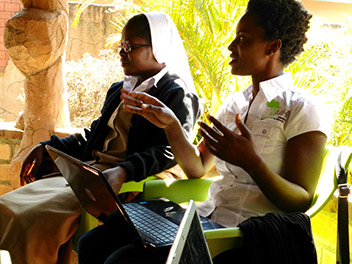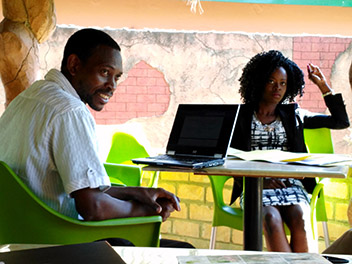 |
 |
 |
 |
notes from the field
These field notes are personal views and do not necessarily reflect the views of Red Cross/Red Crescent Climate Centre
Sierra Gladfelter
Zambia
June 3 - August 23, 2016
Zambia Humanitarian Actors Platform: Establishing a Space for Sharing Best Practices and Influencing National Policy
July 2016
View photo gallery for more photos from the field by Sierra Gladfelter
 From June 30th to July 1st, 2016, I had the honor of participating in a two-day meeting hosted by the Zambia Relief and Development Foundation to share the findings from a study to assess the feasibility establishing a non-state actor’s humanitarian platform in Zambia. Such a network would allow for the activities of humanitarian actors to be more strategically coordinated while also providing a space for exchanging best practices. In addition to consultants from the University of Zambia responsible for conducting the study, representatives from more than a dozen organizations and local institutions working in the humanitarian sector across Zambia were invited to play a key role in defining the next steps forward in establishing a platform for coordinating relief activities and leveraging the organizations’ collective expertise to influence policy. The goal by the end of the two-day meeting was to collectively develop a vision, mission, objectives, governance structure and work plan for formally establishing the Zambia Humanitarian Actors Platform (ZHAP). The shared learning generated through this meeting was hoped to serve as a model to facilitate similar processes in the creation of national platforms for humanitarian actors in other parts of Africa.
From June 30th to July 1st, 2016, I had the honor of participating in a two-day meeting hosted by the Zambia Relief and Development Foundation to share the findings from a study to assess the feasibility establishing a non-state actor’s humanitarian platform in Zambia. Such a network would allow for the activities of humanitarian actors to be more strategically coordinated while also providing a space for exchanging best practices. In addition to consultants from the University of Zambia responsible for conducting the study, representatives from more than a dozen organizations and local institutions working in the humanitarian sector across Zambia were invited to play a key role in defining the next steps forward in establishing a platform for coordinating relief activities and leveraging the organizations’ collective expertise to influence policy. The goal by the end of the two-day meeting was to collectively develop a vision, mission, objectives, governance structure and work plan for formally establishing the Zambia Humanitarian Actors Platform (ZHAP). The shared learning generated through this meeting was hoped to serve as a model to facilitate similar processes in the creation of national platforms for humanitarian actors in other parts of Africa.
The formal establishment of the ZHAP was inspired by remarks made by non-state humanitarian organizations interviewed during the initial feasibility study. Many institutions with rich histories of working in communities on the ground across Zambia lamented how most organizations within the humanitarian sector tend to work “as islands,” with individual voices too weak to be recognized by national policy makers. Instead, humanitarian organizations usually find themselves called upon by the government only in the wake of a disaster, but in a way that is explicitly prescriptive. In other words, many humanitarian actors seem to feel that while asked to assist in cleaning up after natural and human disasters, they have little support in preventative projects or ongoing work to build resilience in communities. Frustrated with feeling as if their recommendations are disregarded and not taken seriously during recovery, many organizations interviewed in the scoping study by faculty at the University of Zambia suggested that a common space was needed for non-governmental and humanitarian organizations to convene and share their collective expertise with one another as well as to strategically lobby for more proactive and socially just policies around disaster prevention, relief, and recovery.
Another recurring comment made by participating institutions during the meeting was concern that the Disaster Management and Mitigation Unit (DMMU), with a mandate under the 2010 Disaster Management Act to coordinate all relief activities in Zambia, does not currently place enough emphasis on disaster risk reduction, community preparedness, and resilience in its long-term recovery activities.
"“We need to act before the disaster!” one workshop participant asserted. “We cannot afford to sit around waiting for the event to occur.”" |
 This conviction, which seemed to resonate among all of the representatives at the planning meeting, became central in ZHAP’s vision statement, which was later articulated in the work groups: to proactively promote a culture of disaster mitigation, management and sustainable recovery across all scales in Zambia. This led to a preliminary discussion about how early action could be encouraged through mechanisms like contingency funds linked to forecasts, disaster finance and other insurance schemes.
This conviction, which seemed to resonate among all of the representatives at the planning meeting, became central in ZHAP’s vision statement, which was later articulated in the work groups: to proactively promote a culture of disaster mitigation, management and sustainable recovery across all scales in Zambia. This led to a preliminary discussion about how early action could be encouraged through mechanisms like contingency funds linked to forecasts, disaster finance and other insurance schemes.
The organizers of ZHAP were explicit that the goal of establishing this platform for non-state actors is not to duplicate the function of DMMU or take over its mandate, but rather to create a space for important humanitarian actors currently marginalized in the broader national conversation around disaster response and recovery to be more engaged in generating creative and just interventions. “Experiences abound,” Simon Mwamba, the ZHAP Coordinator exclaimed. The need now is to create a space to bring these diverse areas of grounded expertise together, to coordinate activities, and to develop a sense of collective legitimacy in order to influence national policy. “We need to understand this as the beginning.”
Initially, I had reservations when I was asked by the Zambia Red Cross Society (ZRCS) to represent them at this meeting. With the focus of the event on group work and debating how to best set up a governance structure appropriate to the desires and needs of the participating institutions, I felt that I would have little to offer. I felt even more humble when I arrived at the hotel where the event was being hosted and found that I was the only non-Zambian in attendance. However, rather than dissolving into the background as a note taker for the ZRCS as I had originally planned, I was intentionally drawn into the conversation due to the nature of my graduate studies by the other participants who made me the secretary and spokesperson for one of the work groups. As my group members representing institutions as diverse as the Green Living Movement, Caritas Zambia, and World Vision Zambia, debated the legal formality necessary for the ZHAP, what its mandate should be, and how to structure membership, I found myself having more and more to contribute.
Although most of my experience with disaster relief and recovery is in South Asia, distant from the specific challenges of organizations and communities working in sub-Saharan Africa, I found that the references that I made to similar governance structures I had encountered in India and Nepal were profoundly useful for guiding the brainstorming process around me. Rather than having situated expertise here in Zambia, my role became sharing strategies and best practices that I had witnessed at India’s National Institute for Disaster Management (NIDM), such as building partnerships with research faculty at local institutions of higher education. Asked by my group to read aloud NIDM’s mission statement and strategic objectives, my group found inspiration in articulating a vision for ZHAP.
"Participating in the development of a governance structure for a formal Humanitarian Actors Platform in Zambia was certainly an inspiring experience. Despite my initial reservations about being the only ‘outsider,’ what I realized is that even though I cannot speak for or represent the decades of work of the ZRCS on the ground in Zambia, I can humbly contribute to such a process in other ways by offering what I have seen and studied in other places. This is, after all, why I wanted to spend time in Africa in the first place: to gain a broader comparative perspective on how disasters exacerbated by climate change are coped with in similar and diverging ways and what lessons in terms of effective climate adaptation are capable of being shared between distinct regions." |
 It would appear such an exchange can begin with the articulation of a vision. For me, it was an honor to have the opportunity to be part of such a profound process: to meet so many dedicated people representing diverse organizations who had come together in the spirit of greater cooperation.
It would appear such an exchange can begin with the articulation of a vision. For me, it was an honor to have the opportunity to be part of such a profound process: to meet so many dedicated people representing diverse organizations who had come together in the spirit of greater cooperation.
Rather than laboring in isolation to end suffering in the wake of disasters, this meeting was the first step in joining hands and moving forward together toward a common vision. With increasingly tight budgets, competition for funding, and limited staff to address the demands of institutional mandates that require a response to challenges as immense as natural disasters, refugee crises, and the HIV/AIDS epidemic, such collaborative projects are few and far between. And yet, they are not only practical from a cost-benefit analysis perspective, but also in the sense of building greater and stronger networks that can collectively engender more change than each group individually.
"this meeting was the first step in joining hands and moving forward together toward a common vision...building greater and stronger networks...can collectively engender more change than each group individually." |

